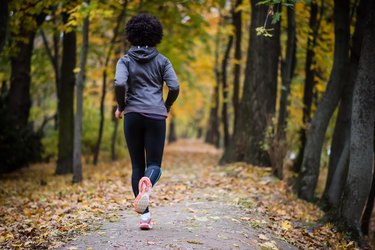
If you've ever suffered a muscle spasm after a workout, you already know the pain and sense of helplessness that sets in when one of your muscles does its best impression of a block of cement. But understanding the potential causes and solutions can help.
Muscle Spasm After a Workout
Video of the Day
Post-workout spasms may be most commonly associated with the charley horse — a nickname for painful muscle spasms in the legs after working out. Sometimes these sudden, tight cramps will also set in during your workout.
Video of the Day
But as the American Academy of Orthopaedic Surgeons (AAOS) explains, sudden muscle cramps can affect any muscle or group of muscles under your voluntary control. They note that although your calf and thigh muscles are most commonly affected, it's also very common to experience camps in your feet, hands, arms, abdomen and rib cage.
As is often the case, scientists are still sussing out the finer details of what can cause exercise-associated muscle cramps. As noted in the March 2018 issue of Materia Sociomedia, the journal of the Academy of Medical Sciences of Bosnia and Herzegovina, the strongest clinical evidence so far supports muscle overload and fatigue as a leading cause of cramps that crop up during exercise.
As noted by the U.S. National Library of Medicine (NLM), there are, unfortunately, a number of other possible causes for a muscle spasm after a workout, during your workout or even at other times. They include:
- Muscle strain or overuse (the most common cause).
- Compressed nerves.
- Dehydration and/or electrolyte imbalance.
- Circulation problems.
- Medication side effects.
- Dialysis side effects.
If you're pregnant, brace yourself: Having a baby on board is another possible cause of muscle cramps, with or without exercise. The NLM notes other populations who may be at increased risk of muscle cramps: athletes, older adults, people carrying some extra weight and those with certain medical conditions including thyroid and nerve disorders.
Handling Muscle Spasms
So you've developed muscle spasms in your legs after working out. There you are on the floor, desperately clutching at your spasming muscle. Is it time to see a doctor? The NLM notes that muscle cramps are typically harmless, and they go away after a few minutes — even if it doesn't feel that way in the moment.
But they also warn that if your cramps are frequent or severe, last a long time or don't get better when you stretch and drink fluids, you should contact your healthcare provider. Other signs that you should seek medical care include cramps accompanied by muscle weakness, swelling, redness or a feeling of warmth.
Here's one more tip from the Mayo Clinic: If your cramps aren't associated with an obvious cause such as strenuous exercise, talk to a doctor. Those muscle spasms might be a signal of some serious health issue going on.
In the moment, the most important solution is to stop doing whatever activity triggered your cramp. Other home remedies suggested by the AAOS include gentle stretching and massage. You can try holding your joint or limb in a stretched position until the cramp stops, but don't force it. Heat might also help for tense or tight muscles.
Once the immediate crisis has passed, the goal is to prevent muscle spasms from happening again. Based on the analysis from Materia Sociomedica, moderating your workouts might be one of the best ways to prevent exercise-related muscle cramps. That doesn't mean you can't work out hard — just don't push it to the point that it triggers muscle spasms.
Another important precaution is to ease your way into workouts by warming up. Harvard Health Publishing explains how: Do five to 10 minutes of exercise that works all your major muscle groups, starting slowly and then ramping up the pace. That could mean walking and swinging your arms, dancing to a few of your favorite songs or doing range-of-motion exercises like lunges, leg swings and arm swings.
After your workout, reverse the procedure by cooling down with five to 10 minutes of gradually lessening physical activity and stretching, all of which can help prevent a muscle spasm after your workout.
Read more: Does Exercise Cause Muscle Twitching?
Was this article helpful?
150 Characters Max
0/150
Thank you for sharing!
Thank you for your feedback!
Is this an emergency? If you are experiencing serious medical symptoms, please see the National Library of Medicine’s list of signs you need emergency medical attention or call 911.